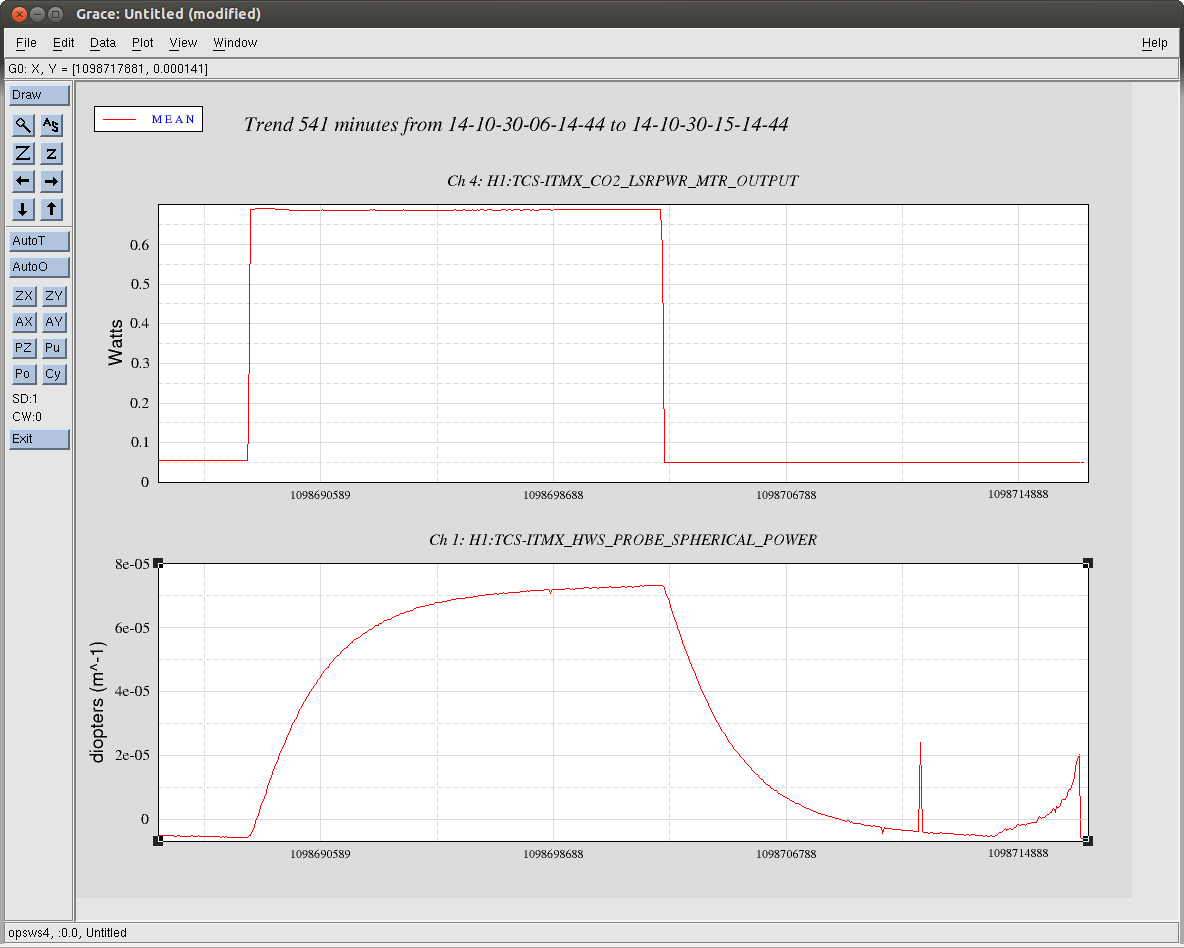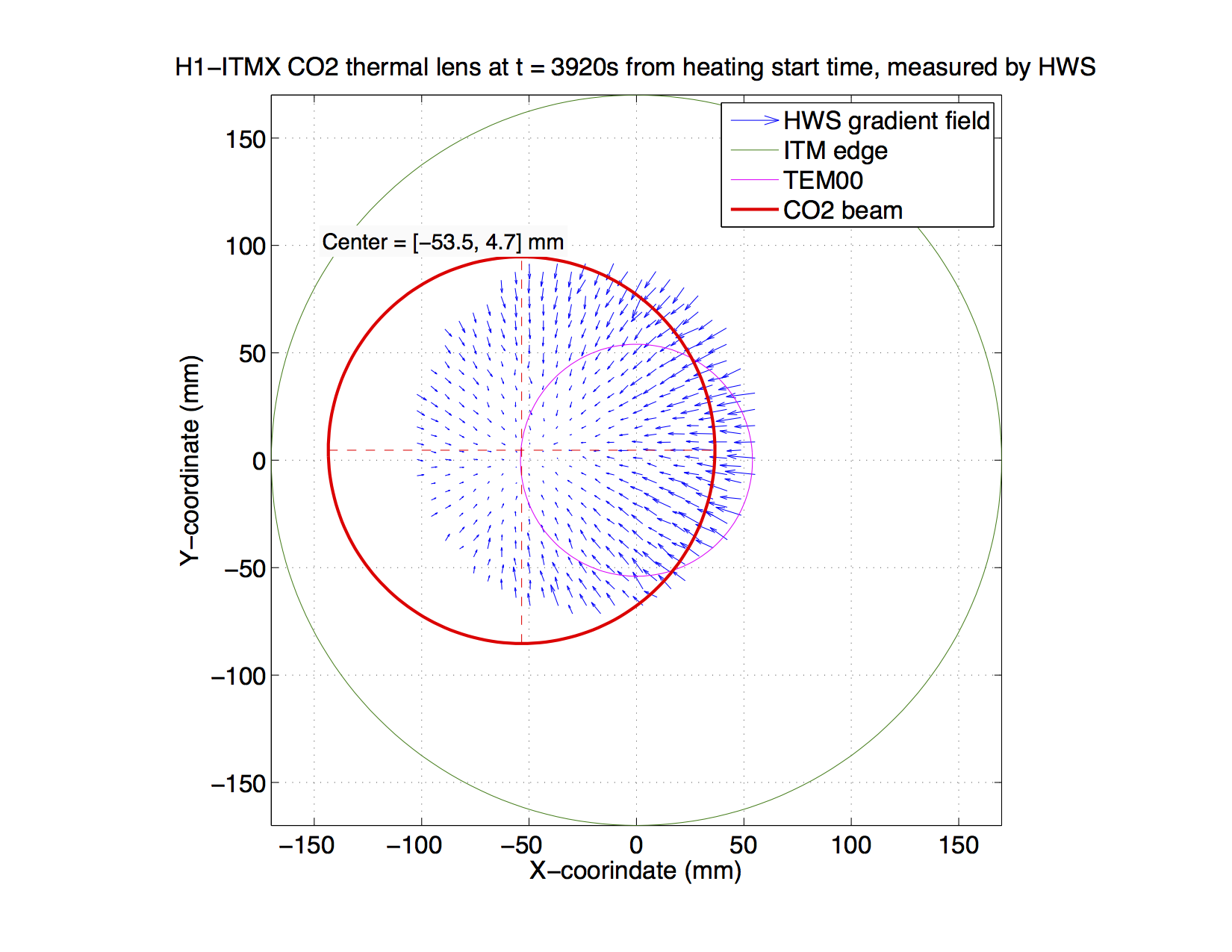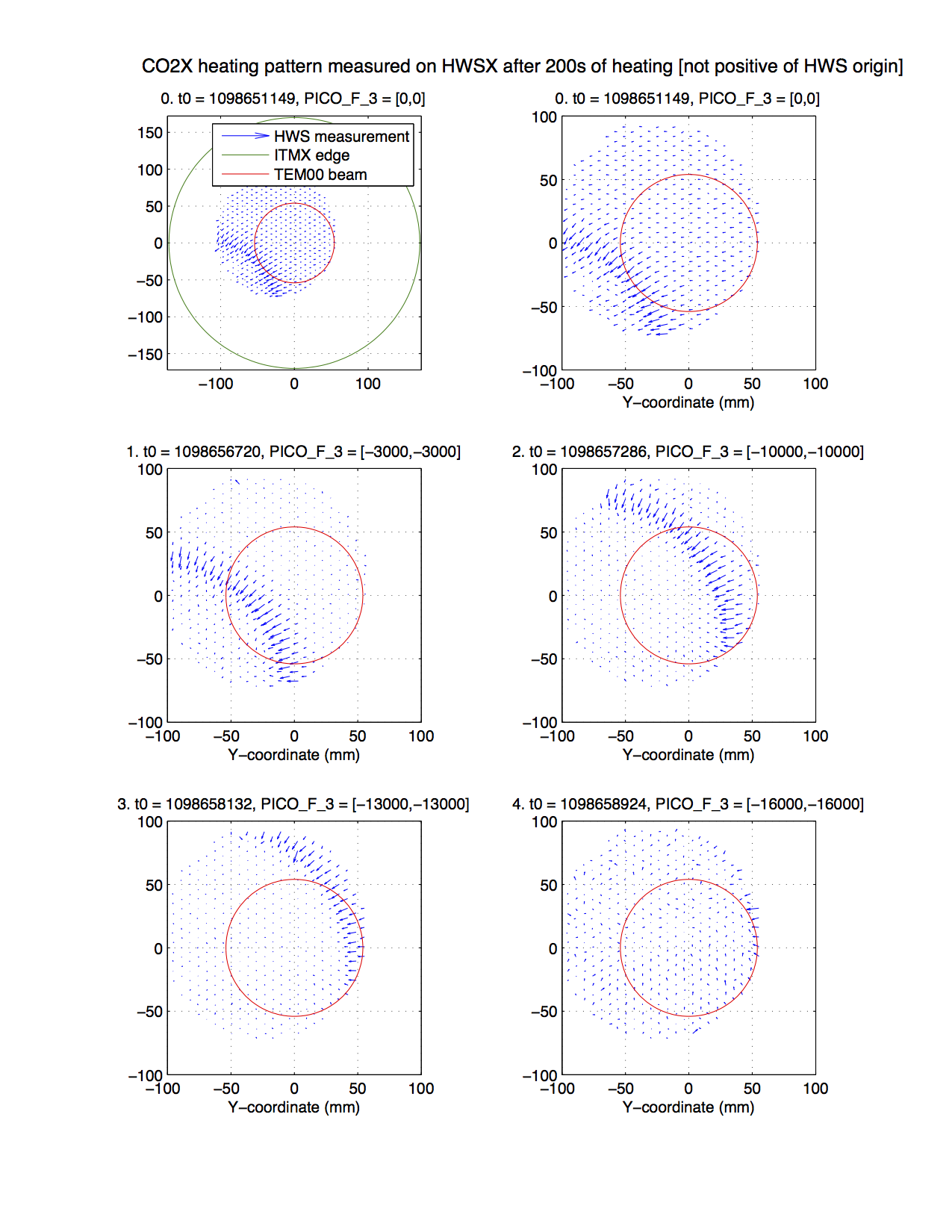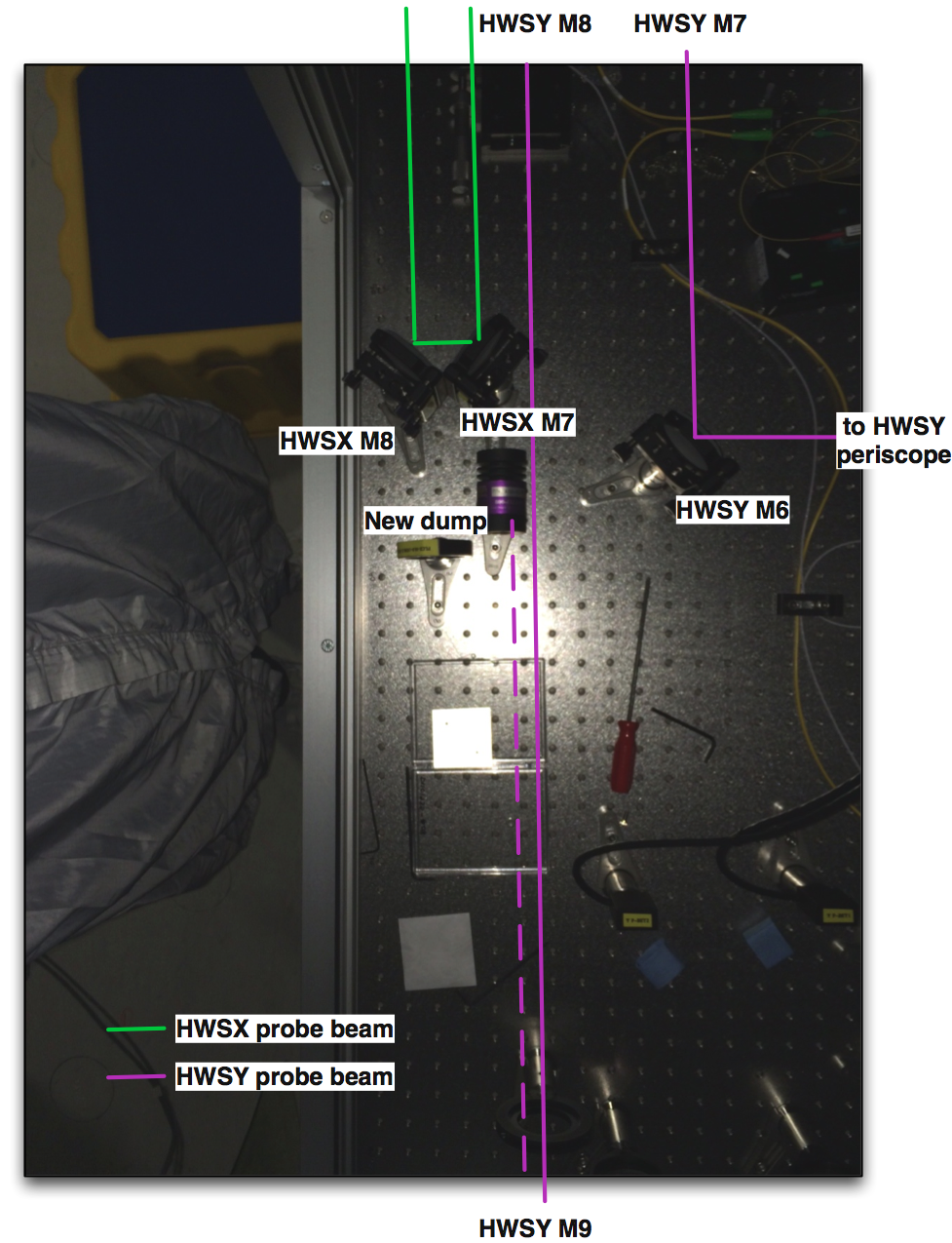Between approximately 10:07 AM PT and 10:16 AM PT the network upstream of LHO had some routing changes or outage that caused a temporary loss of connectivity to the Internet past PNNL/ESnet.
Between approximately 10:07 AM PT and 10:16 AM PT the network upstream of LHO had some routing changes or outage that caused a temporary loss of connectivity to the Internet past PNNL/ESnet.
Bubba, John,
In order to compensate for the cooler weather we have turned on two LVEA heaters at ~ 09:40 local
HC1A is set to 15ma (two stages) - it appears that the first stage is open circuit.
HC2b is set to 9ma (one stage).
There will be a minor impact on LVEA temperatures.
At Peter Fritschel's request, I have extracted lists of science and commissioning channels, as a follow-up to the frame rate studies ( see aLOG 14718 ). I modified my existing script to extract the names (see attached scichannels_script.txt). As a reminder 'acquire=1' means commissioning only, 'acquire=3' means science and commissioning frames. The list of science frame channels is 'h1_sci_channels.txt'. The list of commissioning frame-only channels is 'h1_comm_channels.txt'. Each list has a channel and its rate.
Kyle Ryan, R. Weiss Running the ionizer on purge gas air solves the problem of unequal positive and negative ion currents in the gas being used to discharge the test masses. The oxygen which has known negative ion states provides the bulk of the negative ions. The ionizer was run for 2 hours with sampled + and - ion currents of 1.5e-9 Amps ( a factor of 100 more in the ion stream). Optical HR coating test samples and some VITON pieces were placed in the ion stream to determine if the chemically reactive oxygen ions and ozone formed in the ionizer do damage. The optical samples will be sent to Caltech for absorption tests. The purge air system was turned off at 7:10PM last night.
The 4.5 hour heating test last night on ITMX was successful. The initial thermal lens transient is shown in the attached plot.
The thermal lens forms relatively rapidly in response to the CO2 heating. Then it decays at the same rate when the heating is turned off. Once again, Physics works.
When the offset in the spherical power at t = 0s is accounted for, the thermal lens magnitude is approximately 80 micro-diopters (double-passed) for 680mW of applied CO2 laser power.
Further analysis on the shape and centering of the lens is pending ...
(The noise in the HWS measurement in the last half hour is coming from SUS injections into ITMX).

Further analysis of the HWS measurements of the thermal lens show:
Additionally, I reviewed the thermal lens location over time. The attached plot shows the location of the thermal lens in the ITMX coordinates. The HWS data is correctly positioned in this coordinate system.
The thermal lens center drifted left by 15 mm or so after the first hour or so. I've plotted the center of the lens at earlier time.
The thermal lens center is measured at [-53.5, 4.7] mm. To center this lens we need to move the upper periscope pico (PICO_F_3) by [-8900, +800] counts.
I moved the mirror from [-16012, -16006] to [-24909, -15190].
The CO2X central heating should be centered now.

model restarts logged for Wed 29/Oct/2014
2014_10_29 10:31 h1fw1
unexpected restart of h1fw1
Posting some more details on the parameter changes from the model fitting of H1SR2 discussed in 10124. Some plots showing measured M3 length to pitch coupling against this model and the original model are also attached. The coherence is pretty poor in this data, so it is difficult to draw concolusions on which model is the better predictor of this coupling. Parameters | units | old model | H1SR2 fit | difference | percent difference 'I1x' | kgm^2 [ 0.0213] [ 0.01994] [ -0.0013599] '-6.38%' 'I1y' | kgm^2 [ 0.0025] [ 0.0027219] [ 0.00022193] '8.88%' 'I1z' | kgm^2 [ 0.0216] [ 0.020356] [ -0.0012436] '-5.76%' 'm2' | kg [ 2.983] [ 2.985] [ 0.002] '0.067%' 'I2x' | kgm^2 [ 0.00889] [ 0.0084199] [-0.00047015] '-5.29%' 'I2y' | kgm^2 [ 0.00531] [ 0.0050135] [-0.00029646] '-5.58%' 'I2z' | kgm^2 [ 0.00635] [ 0.0064319] [ 8.1928e-05] '1.29%' 'I3x' | kgm^2 [ 0.00832] [ 0.0080117] [-0.00030834] '-3.71%' 'I3y' | kgm^2 [ 0.0054] [ 0.0051465] [-0.00025352] '-4.69%' 'I3z' | kgm^2 [ 0.00557] [ 0.0053901] [-0.00017987] '-3.23%' 'l1' | m [ 0.295] [ 0.30057] [ 0.0055655] '1.89%' 'l2' | m [ 0.167] [ 0.17123] [ 0.0042327] '2.53%' 'l3' | m [ 0.22] [ 0.22142] [ 0.0014169] '0.644%' 'kc1' | N/m [ 179.8] [ 182.45] [ 2.6509] '1.47%' 'kc2' | N/m [ 219.33] [ 212.9] [ -6.4336] '-2.93%' 'd4' | m [ 0.001] [-0.0006798] [ -0.0016798] '-168%' 'flex1' | m [0.0019381] [ 0.0019382] [ 1.0483e-07] '0.00541%'
Chris, Evan
We have implemented pitch damping by feeding the SR3 oplev back onto M2.
We used the HLTS model susPR3model.mat in NbSVN/aligonoisebudget/trunk/DRMI/L1/TransferFunctions to get a simplified, two-resonance model of the M2 pitch →M3 pitch plant:
Then we added the following filters to foton:
zpk([0],[100],1,"n")zpk([],[50;50;50],1,"n")zpk([0.045+i*3.6;0.045-i*3.6],[],1,"n")zpk([0.03;0.7],[0.141421+i*0.141421;0.141421-i*0.141421],1,"n")gain(0.525002)ellip("LowPass",4,2,40,15)In the attached screenshot, you can see the expected OLTF (in foton) and the measured OLTF (in DTT).
Also in the attached screenshot, you can also see some spectra. Blue is no damping, Green is the existing M3 damping, and red is the new M2 damping. Brown is the control signal for the M2 damping. Evidently, amount of suppression is about the same for the two loops.
We suspect that the bump at 2.5 Hz or so (not to be confused with the suspension resonance at 3.6 Hz) is gain peaking in the loop. Some more optimization may be necessary. Additionally, we need to consider how much noise is being injected into the motion of PR3. We tried for a little while, but realized that (a) we need to get the calibration from counts to newton-meters in order to make sense of the control spectrum, and (b) we haven't yet formulated a noise requirement that the oplev loop must meet.
Also, Suresh has pointed out that the PR3 oplev probably needs recentering; it is at 17 urad in pitch, and the optic's angle fluctuation is showing up in the oplev sum power. This is why we closed the loop on SR3 (recently recentered) rather than PR3.
Repeating work just done at LLO (see aLOG 15385 ), I have run some scripts to count the current H1 rates to frame files for commissioning and science frames. I got copies of the channel lists from the 'daqsvn' SVN server. The script syntax is in (attached) commrates_script.txt. acquire=1 got channels only in commissioning frame (attached h1commrates.txt) acquire=3 got channels only in science and commissioning frame (attached h1scirates.txt) I created additional scripts (see attached calc_comm_rates_table_script.txt) to sum things up by sub-system. See attached h1_comm_rates_table.txt, h1_sci_rates_table.txt. Science frames use acquire=3, commissioning have acquire=1,3 I put this into a spreadsheet (attached H1FrameRates_2014-10-29.xls) and tabulated for Commissioning and Science Frames (see PDFs) Of note: The pre-compression rate of 21.50 MB/s is resulting in a compressed rate of over 12 MB/s (which includes all the EPICS channels). If we compare this to the L1 uncompressed rate of 16.91 MB/s, we see that most of the difference (4.6 MB/s) is because the H1 PEM rate is 6.79 MB/s compared to L1's 2.20 MB/s. At H1, PEM rate is greater than all the ISC data.
As requested by the seismic team, I ran the script to configure the ETMX ISI to a test configuration at around 1:47:00 in UTC or 18:47:00 in PDT. I am leaving it in this configuration.
The configuration was set back to the nominal by running Switch_To_Comm.py (see alog 14695) at around 9:00 am in PDT.
I've set up the script co2X_delayed_start.sh to turn on about 650mW of CO2 central heating on ITMX at 12:05AM. It will turn off after 4 hours.
Aidan. Alastair. Greg.
We started heating ITMX with the central heating beam while running the HWSX sensor. We observed the gradient field of the HWS sensor (created from the difference between before and after 1W of heat applied for 100-200s). The sharp edge of the heating pattern was clearly visible in the gradient field.
We iteratively adjusted the upper periscope mirror on TCS CO2X (PICO_F_3) to adjust the alignment to ITMX. As a roughly calibration we measured 42 mm of motion for 7000 counts applied to the picomotors, or with the signs included:
I'm not 100% confident that the calibration of the center of the optic is correct. However, the HWS gradient field displayed here is adjusted to the coordinates of the test mass using this morning's RH measurement.
Also, note that we're measuring the position of the CO2 laser beam using the transient thermal lens which provides a strong signal at the edge of the heating beam during the initial stages of heating. The measurements below do not represent the steady-state thermal lens which will look significantly different.
However, the bottom line is that the CO2X central heating beam that was not correctly aligned to the center of the test mass is not much closer to being aligned. We will continue to fine tune this tomorrow.
The plot below shows the iterative alignment of the CO2 heating beam. The first and second panels are the original alignment. The second panel is zoomed in around the HWS measurement. The green circle represents the edge of the test mass. The red circle represents the diameter of the TEM00 mode of the IFO. The blue arrows are the HWS gradient field. The strong arc visible in the bottom left corner is the edge of the CO2 heating beam thermal lens. The PICO motor counts for the upper periscope mirror are shown in the titles for the plots.

Aidan.
I upgraded the HWS code to v1.1.5 on H1HWSMSR. This change saves the centroid data as a MATLAB workspace with GPS time in the filename in the FRAMEARCHIVE directory.
Something about the installation on H1HWSMSR is preventing the centroid data being saved in the nominal GWF file format in v1.1.4 of the code, so the v1.1.5 addition is a work around until we fix that installation issue.
Aidan. Alastair.
Around 10:40AM Alastair and I were looking at the ITMX HWS EPICS channels (spherical power, prism, etc) and noticed them getting very noisy. After some discussion with people in the control room, it turned out that there were some white noise injections going into the ETMX suspension.
We started streaming the image from the HWSX camera to the control room - it's peak intensity was around 1500 counts. We misaligned ITMX by several hundred micro-radians, until the return probe beam disappeared from the HWSX stream. There was a residual beam in the image, with a peak intensity of around 300 counts, that was swinging around. We confirmed this was ETMX by changing the pitch of ETMX from 403 to 360 micro-radians and observing the residual beam disappear.
Once the IFO alignment is settled, we will likely need to adjust the HWS alignment so we don't get any return beams from the ETMs.
Alastair, Aidan.
We tracked down the source of the cross-coupling between the HWSY probe beam and the HWSX sensor. The offending beam was coming from the HWSY BS (we think). By blocking the Y-beam at various points we were able to figure out where it was coupling across the HWSX and we subsequently placed a dump in front of it before that point (between M8 and M9 in the Y-arm optical layout - see the attached photo).
One more thing, I checked the following configurations to look for any other stray beams:

Optical Lever Whitening Chassis Rack Locations and Chassis Locations and Current Binary Output Module Status at LHO: D.Cook 10/29/2014 Rack SUS H1-R1: Chassis cabled - Board 1- HAM 2 = No BOM installed Chassis cabled - Board 2- HAM 3 = No BOM installed Rack SUS H1-R2: Chassis cabled - Board 1- HAM 2 = No BOM installed Chassis cabled - Board 2- PR3 = BOM installed B1, B2, B4, B9, B10, B12, 17, B18, B20, B25, 26, B28 set HIGH (the rest set LOW) Rack SUS H1-R3: Chassis cabled - Board 1- HAM 5 = No BOM installed Board 2- SR3 = BOM installed B4, B12, B20, B28 set HIGH Rack SUS H1-R4: Chassis cabled - Board 1- HAM 4 = No BOM installed Chassis not cabled - Board 2- Empty Rack SUS H1-R5: Chassis cabled - Board 1- BSC 8 Pier (temp ?) = No BOM installed (jumpered connecter) Chassis cabled - Board 2- BS = BOM installed B1, B3, B4, B9, B11, B12, 17, B19, B20, B25, 27, B28 set HIGH (the rest set LOW) Rack SUS H1-R6: Chassis cabled - Board 1- ITMx = BOM installed B4, B5, B12, 13, B20, B21, B28, B29 set HIGH (the rest set LOW) Chassis not cabled - Board 2- Empty Rack SUS H1-R1 ETMy: Chassis cabled - Board 1- ETMy = BOM installed B4, B5, B12, 13, B20, B21, B28, B29 set HIGH (the rest set LOW) Chassis not cabled - Board 2- Empty Rack SUS H1-R1 ETMx: Chassis cabled - Board 1- ETMx = BOM installed B2, B3, B5, B10, B11, B13, B18, B19, B21, B26, B27, B29 set HIGH (the rest set LOW) Chassis not cabled - Board 2- Empty
This entry has several bugs making the data incorrect. A corrected status chart can be found in LHO aLOG 14749
08:55 Karen cleaning at mid and end Y 09:03 Ed reinstalling UIM driver for quad test stand 09:05 Hugh bringing HAM2 ISI down to make a safe.snap file 09:24 Gerardo and Alexa transitioning end Y to laser safe (WP 4923) 09:32 Alastair to install FLIR imaging camera on TCS Y table (WP 4924) ... not done, parts need to be made 09:45 Gerardo and Alexa done transitioning end Y to laser safe 10:03 Hugh taking HAM3 down to upgrade matrices and make a safe.snap file 10:12 Truck at gate here to pump septic tank 10:45 Hugh removing malfunctioning HEPI pressure sensor box at BSC2 10:47 Doug cataloguing the status of the switches on the optical lever whitening boards in the LVEA 11:02 Hugh done at BSC2 11:18 Travis moving suspension upper structure into clean room in West bay (heavy) 11:33 Travis done 12:08 Doug done 12:31 Betsy to West bay for 3IFO quad work 12:57 Doug cataloguing the status of the switches on the optical lever whitening boards at the end stations 13:26 Karen done cleaning at mid and end Y 13:48 Hugh to BSC2 to reinstall HEPI pressure sensor box 14:05 Hugh done at BSC2 14:38 Doug in LVEA recording locations of optical lever equipment 14:45 Delivery for Richard 14:45 Doug done
See the attached for some manipulated data.
There are now pressure signals coming from the End Station VEAs just before the BSCs fluid distribution manifolds. So the pressure before the actuators and the pressure just after the actuators (before and after the distribution manifolds.) See the first attachment--you can see that there is some 6psi pressure drop from the last transducer on the Pump Station Manifold to the Transducer just before the supply distribution manifold at the chamber. This is a distance of some 80 or 90 feet of 1" tube.
The idea is that the Actuators are meant to operate at a consistent pressure drop and having the sensors in the area of operation and where we have tighter temperature regulation would be a better thing. While these epics channels can be conditioned (smoothed, averaged,...) the second attachment shows how much noisier these raw signals would be to produce the differential pressure signal for the servo. I've subtracted the Return Pressure from the Supply to get the Differential; the vertical scales are the same for the two EX signals,and the same for the two EY signals. All plots are in PSI.
Why are they so much noisier? Let me see, maybe the 80 or 90 feet of cable? We do have an at chamber active signal amplifier, don't know the DCC off hand but later.
Anyway, I may be a little reluctant to switch HEPI to these signals. I don't think any one has complained about HEPI because we are running on the direct supply pressure rather than the differential.
As RichM pointed out to me, in the second plot, the lower traces of Output Pressure are in loop and the True Differential plotted above are out of loop. I would expect these situations to reverse whence the servo switches to the latter. Additioinally, the first plot which has the max & mins, show the overall noise on the three channels are really the same at the stations; there is certainly more noise on the EY sensors by something like a factor of 2. But you can see how much quieter the mean is on the servo'd channel.
So, I don't think there is sensor noise issue here to worry about.
[Jeff K, Stuart A] Following work yesterday preparing QUAD model updates (see LHO aLOG entry 14645), we convened early this morning to rebuild, install and restart models. A detailed log of our activities follows:- - Bring down the IMC to DOWN state via Guardian (no change to LSC model) - Bring down QUADs to SAFE state via Guardian - Bring down SEI to OFFLINE state via Guardian - Capture new safe BURT snapshots for h1lsc, h1susetmx, h1susetmy, h1susitmx and h1susitmx - Made all QUADs - Installed all QUADs - Restarted all QUADs - Svn-up updated QUAD MEDM screens - Untripped all Watchdogs - Restore QUAD alignments - Restore SEIs to FULLY_ISOLATED via Guardian - Restore IMC to LOCKED via Guardian - DAQ process restart at 14:29 (UTC) - Update other SUS MEDM screens (see LLO aLOG entry 15004) - Cleaned errant IPC issues with diag reset on GDS TP screen - Committed new safe BURT snapshots to svn Summary of benefits: This now makes damping of violin, bounce and roll modes possible via the the L2 (PUM) stage of all QUADs using DARM error. Other benefits include: ESD linearization, providing infrastructure for remote ESD activation and deactivation. Also, old Guardian infrastructure has been removed from the model and MEDM screen, with new Guardian embedded mini control-panel replacing them in the QUAD Overview MEDM screen (as well as for other Suspensions too) This closes-out WP#4915.
We also updated the h1susauxex and h1susauxey models to provide analog and digital monitoring of the ESD Driver, as has been carried out at LLO (see LLO aLOG entry 12688).
The updated local top level SUS QUAD and SUS AUX models have been committed to the svn:- /opt/rtcds/userapps/release/sus/h1/models/ M h1susetmx.mdl M h1susetmy.mdl M h1susitmx.mdl M h1susitmy.mdl M h1susauxex.mdl M h1susauxey.mdl